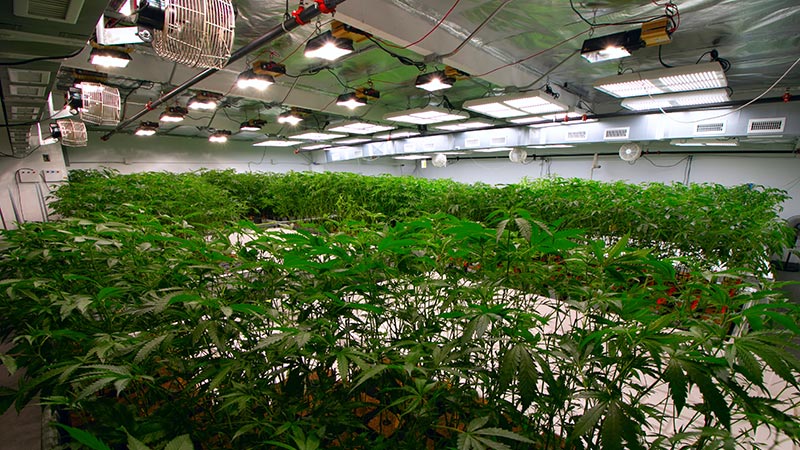
It’s no secret that the recreational and medical cannabis industries across the United States have risen significantly over the last few years. In Michigan specifically, when the marijuana prohibition was lifted on December 1, 2019, lines in Ann Arbor, MI stretched nearly a quarter mile to get in the door. M Live even reported projected sales at nearly $390 million by September 2020, and nearly $1.5 billion by 2022. That being said, the cannabis industry is one that clearly shows much promise for growth and profitability.
With a boom in demand for a new legal product, there will naturally be a need for large quantities of supply—quality supply. In order for a business to grow high-quality product, environmental conditions must be optimal—which means humidity, temperature controls, lighting controls, alarm systems and carbon dioxide levels must consistently be on point, which can most easily and cost-effectively be achieved with building controls. And not only do these elements need to be consistently monitored for production quality, but they also need to meet state regulations for the safety of grow room employees and the surrounding community.
The best way to monitor these components? Building controls.
How Building Automation Systems (BAS) Help Create Optimal Grow-Room Environments
There are a number of elements that must consistently be on point to successfully operate a grow room, but we’ll cover three of the major components today: lighting, humidity and temperature controls. As Surna mentions, logging these data points is crucial to growing a consistent output that consumers can rely on, but manually doing so is tedious and time-consuming, not to mention costly, as it’s such a high-labor task. Installing a control panel will allow for automatic data monitoring and tracking, yielding a more accurate and cost-effective result.
Lighting Controls
Lighting is obviously an essential element in growing any plant—especially marijuana. As explained by cannabis blog Royal Queen Seeds, depending on the stage of growth and strain of cannabis, lighting cycles of 18–24 hours a day, or 12 hours on and 12 hours off, are common. If an employee had to do this manually, labor costs would be extremely high with the need of 24-hour staff. Lighting controls can be fully automated to fit the plants’ growth cycle, offering a much more cost-effective and consistent schedule to help produce the best quality and quantity of product.
However, there’s more to the equation than just timers for lighting. Another article by Surna reports that cultivation lighting produces 3.41 BTU/KW of sensible heat for every hour that it’s in use (regardless of the type of light you’re using), and, with such intense lighting comes high temperatures. To put this even more into perspective, marijuana cultivation accounts for up to one percent of the total energy consumption in the US, and utilize the same bulbs that used to be in streetlights and security light fixtures on industrial buildings. That’s some intense lighting!
While cannabis plants require high temperatures and humidity to grow, there’s a delicate balance for heating and cooling needs to ensure the plants get the elements they need to grow, but the facility is safe from overheating. That’s where humidity/temperature controls and HVAC come into play.
Yeah Humidity & Temperature Controls
Lighting controls and HVAC must work together harmoniously to foster an optimal, yet safe growth environment for both cannabis plants and the people harvesting them. As you could probably infer, indoor and green house plants require extra attention when it comes to climate control. Plants demand closely regulated humidity and temperature levels to stay comfortable. With all indoor environments varying from one another, and even showing variances throughout the day and time of year, it’s critical for growers to implement automated humidity and temperature monitoring controls for optimal product quantity and quality; however, the importance of dehumidifying is just as important as keeping the space properly humid.
The Importance of Ventilation
Think about your bathroom after a shower—it’s steamy and thick with humidity. Without a fan or ventilation system, you’d likely begin to see mold growing on your ceiling and in your shower, which can be detrimental for humans to breathe in. Grow rooms function in a similar manner—they have very high humidity due to plant transpiration and evaporation from overflow trays, which must be dehumidifying or exhausted to remove the moist air and avoid mold problems. As explained by Pro Trade Craft, ventilation is a critical component to the success of a grow room, including elements like make-up air (with an energy recovery ventilator or heat recovery ventilator), as well as floor fans and box fans hung from the ceiling. When tools like water-misters, dehumidifiers, carbon dioxide controls and HVAC systems are automated through one control panel, they are able communicate with each other and maintain an optimal growth environment.
Contact Control Solutions for Your Building Automation Needs!
Control Solutions provides BAS services to grow rooms and facilities throughout all of Michigan, the Midwest, as well as on a national and global level. We listen carefully to our clients’ needs because we understand how important it is for a BAS to work flawlessly for a particular building, its systems, operators, and occupants. If you’re interested in optimizing or upgrading your BAS to produce important metrics such as those above, contact us today to set up an appointment.
Credits:
M LiveSurna (1)
Surna (2)
Royal Queen Seeds
